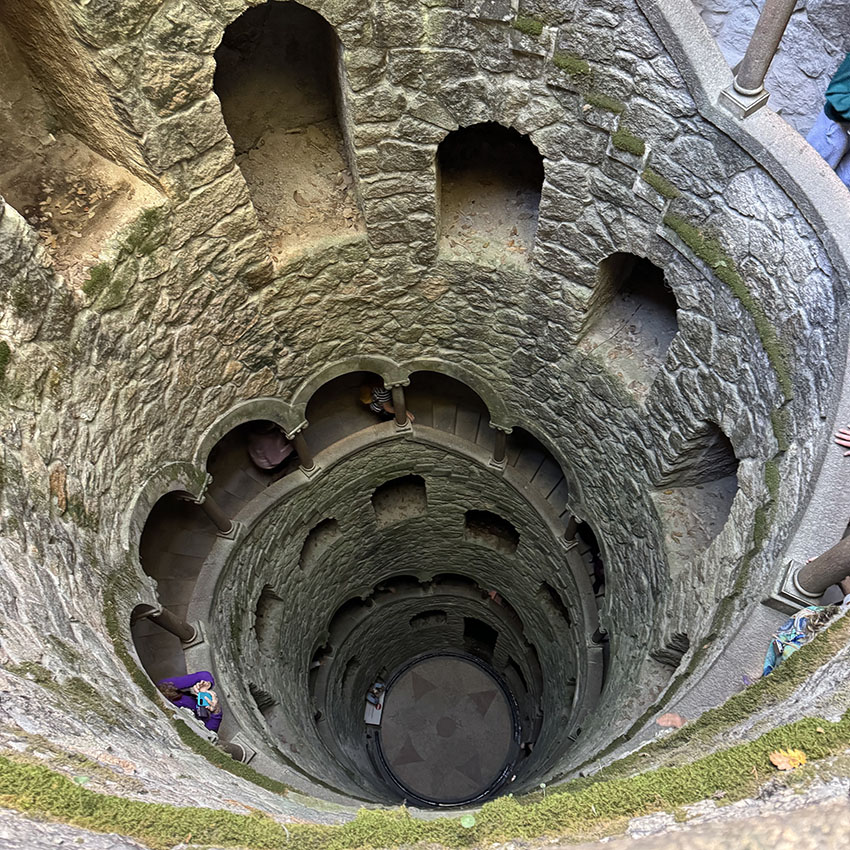
Looking down the Initiation Well
Ah, Portugal! On a recent half-term cruise aboard the stately Queen Anne, my wife, Liz, and I embarked on an unexpected journey that was less about fine dining and more about delving into mystic rites and quirky architecture.
Our plan sounded perfect: visit the intriguing House and Gardens of Quinta da Regaleira, and then top it all off with a civilised afternoon tea at Lawrence’s Hotel.
Little did we know we were about to embark on a somewhat hair-raising initiation of our own.
After a scenic hour’s drive from Lisbon, we arrived in the charming village of Sintra. As the coach rolled to a stop, Liz and I exchanged looks of déjà vu – we’d been here before! Back in 2019, we’d visited for the delightful local shopping and cuisine. But this time, as we strolled through the gates of Quinta da Regaleira, our previous visit felt like a simple warm-up. This was a new adventure entirely.
Now, if you’re ever in Sintra, prepare yourself for an overwhelming dose of Masonic symbols sprinkled with a dash of Dante. We wandered through the gardens, absorbing details from our guide as he led us to the highlight of the tour… brace yourselves… the Initiation Well.
Yes, indeed, an Initiation Well – a 27-metre-deep spiral of stone. Two wells, in fact. One, a grand initiation well, complete with steps spiralling down nine levels, and the other a simpler “unfinished” well, both connected by a series of underground passages. As our guide explained, the nine levels supposedly represent Dante’s circles of Hell, divisions of Purgatory, and the heavenly spheres. I glanced at Liz. We both appreciated a good allegory, but wasn’t this taking Dante a bit literally?
Down we went, step by step – 135 of them, to be exact (for numerologists out there, that’s 15 steps per level, adding up to 9 levels or 1 + 3 + 5 again adding up to 9).
According to legend, initiates once descended this well blindfolded, using only their sense of touch, smell, and sound to guide them. And for good measure, they’d built little cutouts along the way to throw off your balance. Frankly, all I could think was how fortunate it was we weren’t blindfolded – this was definitely a one-way ticket to a sprained ankle!
At the bottom, we found ourselves on a circular mosaic floor in earthy yellows and browns. Of course, there was a Knights Templar cross at the centre, flanked by a compass.
From here, subterranean tunnels led in various directions, but only one would guide the initiate to “pass the test.” Legend has it that if the initiate chose the right passage – marked by the sound of flowing water – they’d succeed. A wrong choice, however, and it’s a polite “better luck next time” on that Masonic membership.
After some time underground, we emerged to find ourselves near a waterfall and a series of stepping stones leading to an exit – as if to evoke walking on water. Naturally, it was all constructed by Carvalho Monteiro, an eccentric Freemason who owned the estate. He’d put this symbolic labyrinth together in the early 1900s, but, alas, passed away not long after its completion, in 1920.
Our initiation to the labyrinth over, we strolled through the estate, admiring a chapel adorned with – yes, you guessed it – Masonic symbols galore. A Knights Templar cross here, an “All Seeing Eye” over the door there. It’s safe to say that Monteiro had an eye for detail, and likely an unparalleled collection of stonemasons in his employ.
Would I recommend it? Absolutely. But if you’re attempting the ritual for real, maybe keep the blindfold off. The initiation may not hold up to historical accuracy, but it’s a captivating place with no shortage of Masonic intrigue and mystery – just don’t forget your sense of humour when descending those 135 steps. And yes, afternoon tea was just as good as it sounds.
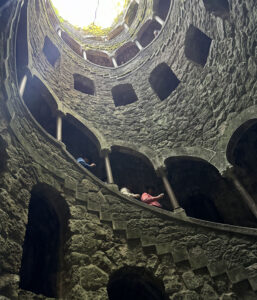 Looking back up the Initiation Well |
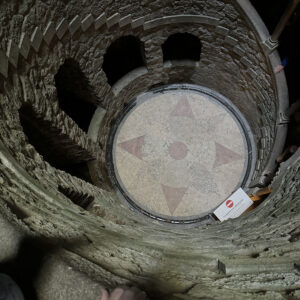 The Mosiac Floor of the Well |
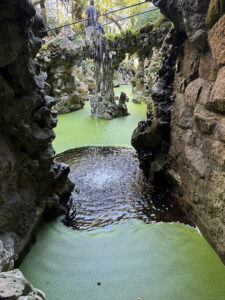 The Waterfall Exit from the Well |
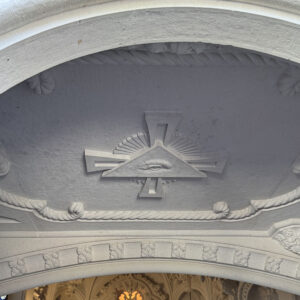 The All Seeing Eye |


